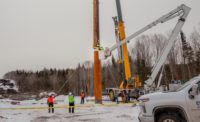To bolster India’s northern power grid, Hindustan Construction Co. (HCC) is constructing the 240-MW Uri-II hydro development power project. The project is a run-of-the-river scheme for the National Hydroelectric Power Corp. (NHPC) on the Jhelum River in the Uri area of the Baramullah district in northern Kashmir. Generating electricity from four 60-MW turbines, Uri-II will not only make the state independent in terms of power but also lend power to other northern states such as Uttarakhand, Uttar Pradesh, Haryana, Delhi, Punjab, Rajasthan and Chandigarh. HCC won the contract in 2005; however, an earthquake delayed initial mobilization by six months.
On-Site
The hydro development, or "hydel," power project involved the construction of a concrete gravity dam, diversion tunnel, head-race tunnel, surge shaft, pressure shaft, powerhouse complex and tail-race tunnel. For the concrete dam, the contractor constructed a diversion tunnel 8.8 meters in dia and 337 m long to channel the water of the Jhelum River. HCC completed this segment on Jan. 11, 2007. The total catchment area of the dam site is 13,400 sq kilometers, and the concrete gravity dam is about 52 m in height and 157 m in length. Apart from this, the project’s head-race tunnel is 4.23 km in length and 8.4 m in dia. Other structures include a restricted orifice-type surge shaft of 25 m dia and a 3.61-km tail-race tunnel. The project also includes four spillways of 9 m each in the dam to divert water to the tunnel for power generation. The underground powerhouse, 133 m in length, 15 m in width and 40 m in height, accommodates four turbines.
The Geology
The Uri-II project lies in the eastern part of the Kashmir region of the northwest Himalayas and is occupied by quaternary deposits and sedimentary rocks of the upper Murree formation. The company's project team carried out in-depth investigations to ensure successful construction in these harsh conditions. Safety measures were used in the form of rock support through methods such as wire mesh, shotcrete, steel rib, rock bolt and rock anchor. The dam structure required a total of 100,000 cu m of concrete.
Tunneling
While excavating the head-race tunnel, the contractor encountered rock of classes three and four. Tail-race tunnel (TRT) engineers had to deal with 223 m of riverine materials comprising earth mixed with boulders and heavy seepage of about 15,000 litre per minute. To excavate in these very loose earth strata, the crew blasted exposed boulders on the face and removed the surrounding earth with excavators. Then, they stabilized the tunnel face with shotcrete and grout and deployed dewatering pumps to tackle seepage. HCC installed specialized pipe roofing using Mai anchors as an umbrella to avoid loose fall from the crown of the tunnel. Crews lined the entire tail-race tunnel with reinforced concrete.
Dewatering
In the tail-race tunnel, powerhouse and dam area, the seepage encountered was huge as the channels crossing over the TRT alignment and the crown of the underground powerhouse were designed 22 m below the river's water level. The project team ensured uninterrupted dewatering in the TRT, powerhouse and dam area till the project was completed. The total dewatering quantity in this project was 345-million kW-hours, and the total electrical cables used to maintain this dewatering arrangement in the tunnels was 15,000 m.


Post a comment to this article
Report Abusive Comment